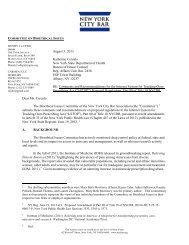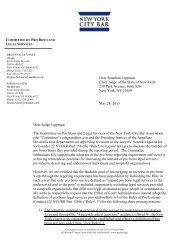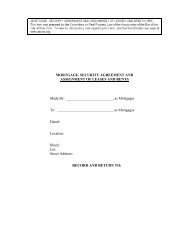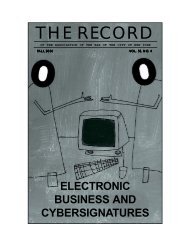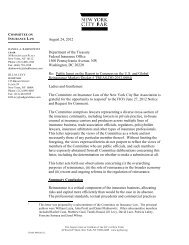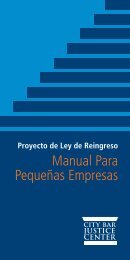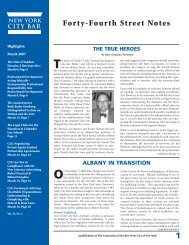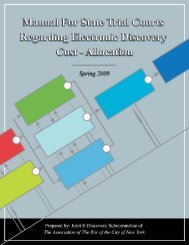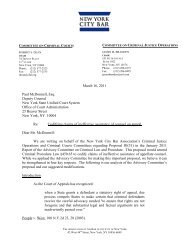2007 Issue 1 - New York City Bar Association
2007 Issue 1 - New York City Bar Association
2007 Issue 1 - New York City Bar Association
Create successful ePaper yourself
Turn your PDF publications into a flip-book with our unique Google optimized e-Paper software.
J U D I C I A L S E L E C T I O N T A S K F O R C E<br />
for election from a judicial district (“the justices of the supreme court<br />
shall be chosen by the electors of the judicial district in which they are to<br />
serve”). However, solely for the purpose of nominating justices of the Supreme<br />
Court, each judicial district shall be subdivided into judicial convention<br />
districts consisting of either two or three assembly districts. Each<br />
position of justice of the Supreme Court presently filled by elections held<br />
within each judicial district shall be assigned to, and nominations shall<br />
be made from, one of the various judicial convention districts within<br />
each judicial district. Notwithstanding that a person may have been nominated<br />
from a particular judicial convention district, the person shall run<br />
at-large throughout the entire judicial district in which the judicial convention<br />
district is located. All registered voters residing in the judicial<br />
district shall be eligible to vote in the general election for justice of the<br />
Supreme Court.<br />
2. The judicial convention districts shall be grouped into eight regional<br />
districts covering roughly the following geographical areas: (1) Long<br />
Island; (2) <strong>New</strong> <strong>York</strong> <strong>City</strong>; (3) Hudson Valley; (4) Capital Region; (5)<br />
Adirondacks; (6) Finger Lakes; (7) Southern Tier, and (8) Western <strong>New</strong><br />
<strong>York</strong> (the “Regions”). Notwithstanding the foregoing, within a variance<br />
of one, each Region shall contain an equal number of judicial convention<br />
districts. An independent and diverse judicial qualification commission<br />
(“JQC”) shall be established within each Region.<br />
3. JQCs should be established to review the qualification of candidates<br />
for all levels of judgeships, beginning with the Supreme, District<br />
and <strong>City</strong> Courts, the Civil Court of the <strong>City</strong> of <strong>New</strong> <strong>York</strong>, the Surrogate<br />
and County Courts and the Family Court outside the <strong>City</strong> of <strong>New</strong> <strong>York</strong><br />
(collectively, the “Covered Judgeships”).<br />
4. There shall be 21 members of each JQC. The Chief Judge, the Governor,<br />
the presiding Justices of each Appellate Division in which the Region<br />
sits and the highest ranking members of each party in the Senate<br />
and in the Assembly (collectively, the “Governmental Appointing Authorities”)<br />
shall appoint, from each Region, 15 to 21 (depending on the number<br />
of the members of the JQC to be formed) bar associations, law schools<br />
and/or not-for-profit civic or community organizations (collectively, the<br />
“Non-Governmental Appointing Authorities”), and each one of the Non-<br />
Governmental Appointing Authorities shall then in turn appoint one<br />
member of the JQC. The Governmental Appointing Authorities shall give<br />
consideration to achieving a broad representation of the communities<br />
within each Region when appointing the Non-Governmental Appointing<br />
Authorities, including race, ethnicity, gender, religion, and sexual ori-<br />
T H E R E C O R D<br />
112



